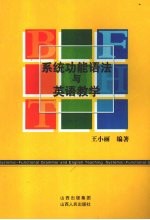

系统功能语法与英语教学PDF电子书下载
- 电子书积分:9 积分如何计算积分?
- 作 者:王小丽编著
- 出 版 社:太原:山西人民出版社
- 出版年份:2007
- ISBN:7203057879
- 页数:198 页
Chapter 1 College EFL Reading Teaching and Systemic-Functional Grammar 1
1.1 The EFL Reading Teaching of Non-English Majors in China 2
1.1.1 Situation in general 2
1.1.2 Importance of reading teaching in the intensive reading course 3
1.1.3 The probability and necessity of applying Systemic-Functional Grammar to the EFL reading teaching 4
1.1.3.1 Problems existing in the EFL reading teaching 4
1.1.3.2 Requirements of Requirements 6
1.1.3.3 The probability and necessity of applying Systemic-Functional Grammar to language teaching 7
1.2 What is an Effective reader? 10
1.3 General Review of Systemic-Functional Grammar 13
1.3.1 Historical review of Systemic-Functional Grammar 13
1.3.2 Theoretical review of Systemic-Functional Grammar 15
1.3.2.1 Two main components 15
1.3.2.1.1 Systemic Grammar 15
1.3.2.1.2 Functional Grammar 16
1.3.2.2 Six core ideas 17
1.3.2.2.1 Metafunctional idea 17
1.3.2.2.2 Systemic idea 19
1.3.2.2.3 Stratificational idea 20
1.3.2.2.4 Functional idea 21
1.3.2.2.5 Contextual idea 21
1.3.2.2.6 Probabilistic idea 22
1.4 The Relevance of Systemic-Functional Grammar to the EFL Reading Teaching 22
1.5 Organization of the Book 24
Chapter 2 Contextual Theory and Its Application to the EFL Reading Teaching 26
2.1 Scholars'Views on Context 27
2.1.1 Overseas scholars'views on context 28
2.1.1.1 B.Malinowski's view 28
2.1.1.2 J.R.Firth's view 30
2.1.1.3 M.A.K.Halliday's view 31
2.1.1.4 J.Lyons'view 33
2.1.2 Chinese scholars'views on context 34
2.1.2.1 Hu Zhuanglin's view 34
2.1.2.2 He Zhaoxiong's view 35
2.2 The Application of Context to the EFL Reading Teaching 36
2.2.1 Context and reading comprehension 36
2.2.1.1 Linguistic context and reading comprehension 36
2.2.1.2 Situational context and reading comprehension 39
2.2.1.3 Cultural context and reading comprehension 42
2.2.2 Contextual analysis in teaching efficient reading comprehension skills 44
2.2.2.1 Prediction 45
2.2.2.1.1 Global prediction 45
2.2.2.1.2 Local prediction 47
2.2.2.2 Main ideas 49
2.2.2.2.1 Explicit main ideas 49
2.2.2.2.2 Implicit main ideas 52
2.2.2.3 Inference 53
2.2.2.3.1 Implied meaning 53
2.2.2.3.2 Attitude 54
2.2.2.3.3 Tone 56
2.2.3 Analysis of a passage 57
2.3 Summary 61
Chapter 3 Cohesion Theory and Its Application to the EFL Reading Teaching 63
3.1 A Brief Introduction to Cohesion Theory 65
3.1.1 The concept of cohesion 65
3.1.2 The classification of cohesion 68
3.1.2.1 Reference 68
3.1.2.1.1 Endophora and exophora 68
3.1.2.1.2 Personal reference,demonstrative reference and comparative reference 70
3.1.2.2 Substitution and ellipsis 78
3.1.2.3 Conjunction 85
3.1.2.4 Lexical cohesion 87
3.1.2.4.1 Reiteration 87
3.1.2.4.2 Collocation 88
3.2 The Application of Cohesion to the EFL Reading Teaching 90
3.2.1 The role of cohesion in reading comprehension 90
3.2.2 The application of cohesion theory to the EFL reading teaching 92
3.2.2.1 Reference 92
3.2.2.2 Substitution and ellipsis 96
3.2.2.3 Conjunction 99
3.2.2.4 Lexical cohesion 106
3.2.3 Analysis of a passage 111
3.3 Summary 116
Chapter 4 Thematic Theory and Its Application to the EFL Reading Teaching 117
4.1 A Brief Review of Thematic Theory 118
4.1.1 Theme and Rheme 118
4.1.2 Classification of Theme 121
4.1.2.1 Classification in terms of probability 121
4.1.2.1.1 Theme in declarative clauses 122
4.1.2.1.2 Theme in interrogative clauses 122
4.1.2.1.3 Theme in exclamative clauses 122
4.1.2.1.4 Theme in imperative clauses 123
4.1.2.2 Classification in terms of complexity of structure 123
4.1.2.2.1 Simple theme 123
4.1.2.2.2 Multiple theme 126
4.1.2.2.3 Clausal theme 128
4.1.2.2.4 Theme in special structural patterns 129
4.1.3 Thematic progression 130
4.1.3.1 Linear thematic progression 131
4.1.3.2 Parallel thematic progression 134
4.1.3.3 Constant thematic progression 136
4.1.3.4 Derived thematic progression 137
4.1.3.5 Crossing thematic progression 140
4.1.3.6 Alternating thematic progression 141
4.1.3.7 Summarizing thematic progression 143
4.2 The Application of Thematic Theory to the EFL Reading Teaching 145
4.2.1 Train students to scan for the key information and follow the writer's underlying concerns 148
4.2.2 Train students to follow the writer's train of thought and accelerate their reading speed 149
4.2.3 Train students to understand the whole text 158
4.2.3.1 Thematic progression of narration 160
4.2.3.2 Thematic progression of description 164
4.2.3.3 Themaitc progression of exposition 168
4.2.3.4 Thematic progression of argumentation 170
4.3 Summary 175
Chapter 5 Genre Theory and Its Application to the EFL Reading Teaching 178
5.1 Genre Theory 179
5.2 The Application of Genre to the EFL Reading Teaching 182
5.2.1 Genre-based teaching approach 183
5.2.2 The importance of genre analysis in reading 184
5.2.3 Reading teaching practice of genre-based approach 185
5.3 Summary 189
Bibliography 191
- 《高级英语阅读与听说教程》刘秀梅编著 2019
- 《思维导图 超好用英语单词书》(中国)王若琳 2019
- 《培智学校义务教育实验教科书教师教学用书 生活适应 二年级 上》人民教育出版社,课程教材研究所,特殊教育课程教材研究中心编著 2019
- 《初中生英语作文 提高篇》清瑶主编 2019
- 《培生高级英语语法 练习册》培生教育 2019
- 《指向核心素养 北京十一学校名师教学设计 英语 七年级 上 配人教版》周志英总主编 2019
- 《365奇趣英语乐园 世界民间故事》爱思得图书国际企业 2018
- 《新课标背景下英语教学理论与教学活动研究》应丽君 2018
- 《幼儿英语游戏活动指导与实训》苏小菊,任晓琴主编;颜晓芳,覃静,谢恬恬,钟博维副主编 2020
- 《剑桥国际英语写作教程 段落写作》(美)吉尔·辛格尔顿(Jill Shingleton)编著 2019
- 《市政工程基础》杨岚编著 2009
- 《家畜百宝 猪、牛、羊、鸡的综合利用》山西省商业厅组织技术处编著 1959
- 《《道德经》200句》崇贤书院编著 2018
- 《高级英语阅读与听说教程》刘秀梅编著 2019
- 《计算机网络与通信基础》谢雨飞,田启川编著 2019
- 《思维导图 超好用英语单词书》(中国)王若琳 2019
- 《看图自学吉他弹唱教程》陈飞编著 2019
- 《法语词汇认知联想记忆法》刘莲编著 2020
- 《培智学校义务教育实验教科书教师教学用书 生活适应 二年级 上》人民教育出版社,课程教材研究所,特殊教育课程教材研究中心编著 2019
- 《国家社科基金项目申报规范 技巧与案例 第3版 2020》文传浩,夏宇编著 2019
- 《办好人民满意的教育 全国教育满意度调查报告》(中国)中国教育科学研究院 2019
- 《人民院士》吴娜著 2019
- 《中国人民的心》杨朔著;夕琳编 2019
- 《中华人民共和国成立70周年优秀文学作品精选 短篇小说卷 上 全2册》贺邵俊主编 2019
- 《中华人民共和国成立70周年优秀文学作品精选 中篇小说卷 下 全3册》洪治纲主编 2019
- 《中华人民共和国药典中成药薄层色谱彩色图集》(中国)国家药典委员会 2019
- 《北京人民艺术剧院剧本系列 白露》刘国华,马鹏程 2019
- 《山西文华项目图书 山西古代寺观彩塑 辽金彩塑 第1册》(中国)张明远 2019
- 《中华人民共和国成立70周年优秀文学作品精选 中篇小说卷 上 全3册》洪治纲主编 2019
- 《中华人民共和国国歌 钢琴谱》聂耳编 2019
